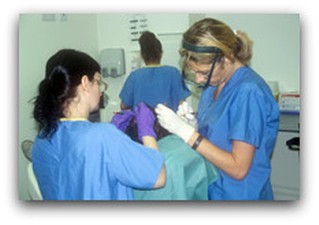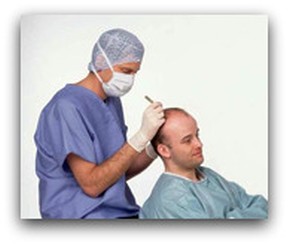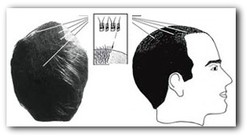Kendal Hair Care Centre
Hair Restoration Surgery
Trichology


MicroGrafting
MicroGrafting Hair Restoration Surgery is a guaranteed way to restore hair permanently. It is the most successful method of restoring hair to a particular area of the scalp, and has become one of the most popular forms of elective cosmetic surgery for men. The procedure has undergone many advances on the original surgical grafting techniques, with hair restoration science, surgical technology, artistic knowledge and ability, having evolved to an extent that it is now a highly sophisticated, yet simple operation. In particular, it has developed into a fine-art form with greater time, experience, and artistry required by the hair surgeon so as to create the most natural-looking results every time; with care and attention to detail, the very best surgery is undetectable, even under the closest scrutiny, a standard by which all results are now judged. MicroGrafting can be performed safely, painlessly, and successfully, with very impressive results, but does demand patience and perfectionism from the practitioner.
Modern methods now concentrate on procuring an extensive number of closely-placed, very fine individual grafts, or follicular units of one, two, or three hair follicles, which are carefully transplanted into the balding, or thinning scalp, to manufacture the most desirable combination of density with the essential ingredient of a natural look.
This provides a recognised, proven, effective and guaranteed way of re-establishing healthy and permanent hair growth from these areas; greater density can be achieved subsequently if required.
Unnatural large empty spaces, quite often a familiar outcome following previous methods of hair surgery, no longer exist. In fact, MicroGrafting can be used to re-dress the problems of earlier transplanting even to the point of removing grafts and re-using and distributing the hairs in a more refined and natural manner
Essentially, MicroGrafting Hair Restoration Surgery is a simple, minor procedure carried out under local anaesthetic, whereby a select amount of good healthy growing hair, located at the back or sides of the scalp ('donor' hair), which is unaffected by male pattern baldness, and genetically programmed to continue growing indefinitely, is removed, transferred and re-distributed to those areas of the scalp in greater need; once relocated, this hair will continue to grow as before, and can eventually be cut, washed, styled, or permed as normal and remain life-long.
The advantage of MicroGrafting is its flexibility. As hair loss is largely a gradual development, you can pursue corrective treatment as your hair loss progresses, whether it is to the hairline, temples, or 'crown area' for example, thus always ensuring you maintain a good head of hair.
Conversely, a comprehensive coverage with a generous amount of MicroGrafting can be accomplished over an extensive bald, or balding area, the resulting cosmetic effect offering an extremely pleasing contrast to the earlier condition; a visually fuller head of hair can be achieved with greater density through additional MicroGrafting at a later stage.
Surgically increasing hair density, or replacing lost hair as time passes, satisfies most patient's objectives.
Sometimes performed in conjunction with MicroGrafting Surgery is a Baldness Reduction procedure, which can be a very effective, dramatic, and fairly immediate solution to reducing, or even eliminating baldness; however, suitable candidates have to be very carefully selected and appraised.

Donor Hair Removal
Option A (Strip Method)
Donor hair is removed in the form of a strip (and concealed) - then dissected into small grafts, or individual follicular units.
Option B (FUE Method)
Donor hair is removed in the form of small grafts, or individual follicular units, extracted one-by-one.
Donor Hair Relocation
Small grafts, or individual follicular units, are transplanted into the recipient areas creating a natural looking increase in hair density.
Your questions answered
Over the years we have been asked almost every question imaginable. Listed below are the questions that seem to come up most often, along with our answers. However, for your own peace of mind we suggest you make an appointment to come in and ask your questions to us directly.
- Are hair transplants permanent? Do they really work?
Yes. They last a lifetime. We re-distribute existing permanent hair to your thin area, guaranteeing over 95% of the grafts will grow permanent hair.
- Do they look natural?
Yes. Because Surgeons no longer use the punch graft technique, carefully performed micro hair transplants look completely natural. The tufty "dolls head" appearance no longer applies. Single hair micro grafting creates a genuinely undetectable and natural hairline.
- Is this a painful procedure?
Don't worry. Local anaesthetic permits painless removal of grafts, any slight discomfort after the procedure is relieved by Paracetemol.
- Are any bandages necessary?
No. Our experience shows that there is no need for bandages.
- Do hair transplants leave scars?
No. Hair transplants performed by skilled surgeons can only be detected by thorough expert examination.
- What will happen to the donor area from which the hair is taken?
The donor area is sutured with an absorbable stitch. The area shrinks to a small hardly discernible scar, well hidden by surrounding hair.
- When does the hair start to grow?
The hair starts to grow vigorously between 10 and 12 weeks and produces a good growth of natural hair. As this is your own growing hair you can treat it as normal i.e. shampooing, styling, application of hair products gels/mousses etc. You can also carry on with all normal sporting activities. Don't forget this is your own growing hair.
- How many operations will be necessary?
This varies from patient to patient depending upon the size of the bald area to be treated. The number of sessions would be estimated at your initial FREE assessment consultation.
- Do I need time off work after my transplant?
For most people, little or no time off work is necessary as the procedure is carried out as a day case.
How much will it cost?
Not as much as you may think! In fact our clients are very surprised when they are quoted the final, all inclusive fee. To give you some idea, you could draw a comparison with the cost of having a good family holiday. Individual financial plans can be arranged to suit your personal requirements.

A typical example of a patient immediatly after a MicroGrafting Hair Surgery operation
The same patient after 6 months following MicroGrafting Hair Surgery
Things You Need To Know
- Transplanting hair follicles is neither a complex, nor a particularly difficult procedure – Hair Restoration Surgery, through MicroGraft transplantation is essentially a simple, minor procedure carried-out under local anaesthetic, but very dependant on artistic skill and attention to detail.
- In general, a narrow ‘strip’ of good healthy-growing, hair-bearing scalp (‘donor’ hair) is removed from the back, or sides, which is then sutured; using microscopic and micro-surgical instruments, the ‘strip’ is carefullydissected into the requisite number of individual hair grafts/follicular units, which are then inserted into small incisions, or ‘pin-pricks’ made in the recipient bald scalp.
- Follicular Unit Extraction (FUE) is an alternative to the ‘strip’ method and a less invasive way of obtaining ‘donor’ hair; in this, each required follicular unit is removed with exact precision one-by-one, before re-planting into the ‘new’ location.
- Most potential patients are candidates for Hair Restoration Surgery as long as there is adequate quality hair to donate from the back, or sides of the scalp, or the body.
- Little or no pain is endured, but mild discomfort can be experienced after the operation; no dressing is required however, with minimal bleeding and swelling, and protection for the new grafts is not necessary. As with any operation there are always risks of infection and bleeding, but these are, fortunately, very rare, and never prove to be serious.
- Crusting will form over each of the ‘new’ grafts, and at the sutured ‘donor’ site, but regular shampooing will help to speed up the healing process,and within 7 –10 days it is normal that most of the crusting will have come-away with the remainder following very quickly; any signs of surgery will soon be eliminated.
- It is not unusual for some of the transplanted grafted hair to come away, with the loose crusts – this is perfectly normal, leaving the dormant follicles safely behind to produce ‘new’ hair in due course. On occasions, the original hair can remain behind and continue to grow in its ‘new’ location from the day it was transplanted.
- It is important to realise that newly transplanted hair doesn’t appear ‘all at once’ but is a gradual process, maximum results being achieved once all the hair has grown to a reasonable length. Only extremely limited growth is seen within 3 months, and it takes a full 6 months before final results can be seen and assessed.
- It is probable that 100% reliability of hair growth will be achieved, producing hair coverage, which should be maintained for the rest of the life of the patient.
- You only need to take one day out of your typical weekly schedule, and depending upon your occupation, and the extent of hair grafting performed for you,
- you can return to work the following day if you wish; however, it is advisable to take a few days break (such as a weekend or bank holiday)
- A patient need only have one session of MicroGraft Hair Surgery to improve the density of hair coverage, and to look totally natural; subsequent sessions to increase density even further, are at the patient’s discretion.
- In Baldness Reduction Surgery, the ultimate completion of the procedure is likely to take 2 or 3 sessions overall; MicroGraft Surgery may be necessary subsequently.